temperature
Latest

Amazon responds to backlash with increased protection for workers
Early this week, workers from Amazon, Whole Foods and Instacart walked off the job to protest what they say is a lack of protections against COVID-19. Now, Amazon is sharing its plans to increase employee temperature checks and provide surgical masks to workers across the US and Europe.
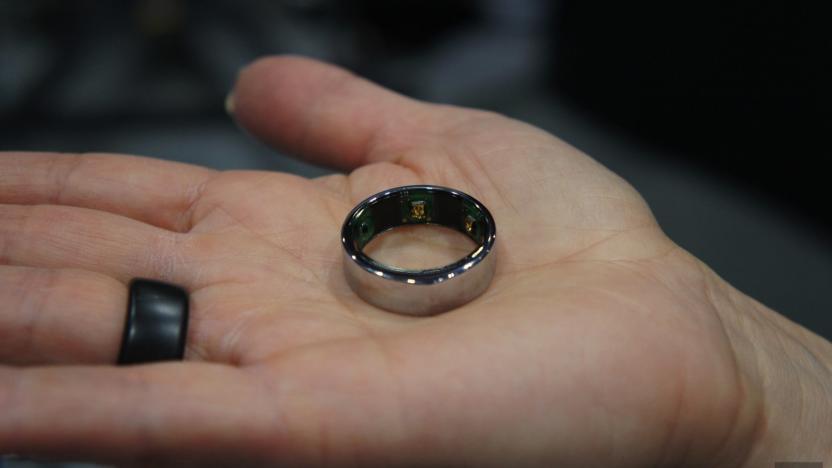
ER docs don smart rings to better predict COVID-19 infections
Some 2,000 emergency medical workers in San Francisco are tracking their temperature and other vitals with Oura's smart rings in an attempt to limit the spread of COVID-19, SF Chronicle reports. Oura and researchers from the University of California San Francisco (UCSF) hope to use that data to develop an algorithm that will predict the onset of COVID-19 and help contain the virus.

Antarctica is hotter than it's ever been
Temperatures in Antarctica have reached a record high. According to Argentinian research station thermometer, the temperature climbed to 18.3 degrees Celsius, or 64.9 degrees Fahrenheit. That beats Antarctica's previous record of 63.5 degrees, measured in March 2015, by nearly 1.5 degrees Fahrenheit.
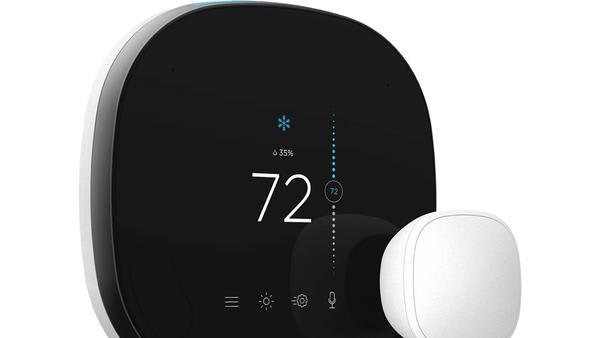
Ecobee's eco+ update adds five cost-saving features (updated)
Smart thermostat maker Ecobee has just announced a new free update called eco+ that it claims will save you even more money when you use one of its devices. Ecobee is first rolling out eco+ to its latest product, the SmartThermostat. It'll push the update to its other thermostats -- including the Ecobee 4, Ecobee 3 and Ecobee 3 Lite -- starting in early 2020. To get the update, you'll need to download the latest version of the Ecobee mobile app.

New models show that the earth is warming faster than first thought
Scientists have made no secret of the extreme challenges posed by climate change, with the Intergovernmental Panel for Climate Change (IPCC) repeatedly stressing the importance of keeping global warming below two degrees. But now it seems the situation is much more serious than previously understood, with new climate models predicting average temperatures could rise by as much as seven degrees by 2100.
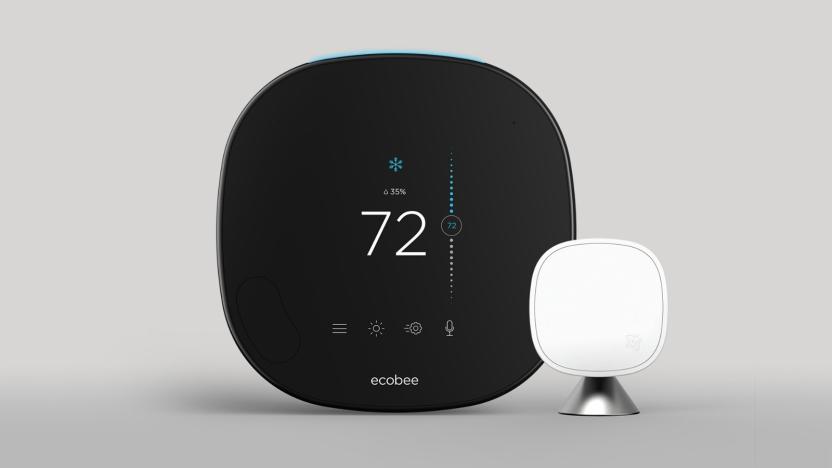
Ecobee unveils its latest Alexa-powered smart thermostat
This morning, Ecobee released details on its latest voice-controlled smart thermostat. Rumors circulated last week when the device appeared briefly on the Lowe's website. Today, Ecobee made it official. Breaking away from its numbered naming scheme -- Ecobee 3, Ecobee 3 Lite and Ecobee 4 -- the company is calling this one, simply, the SmartThermostat. Ecobee says it's "packed with the power you would expect from a smartphone."
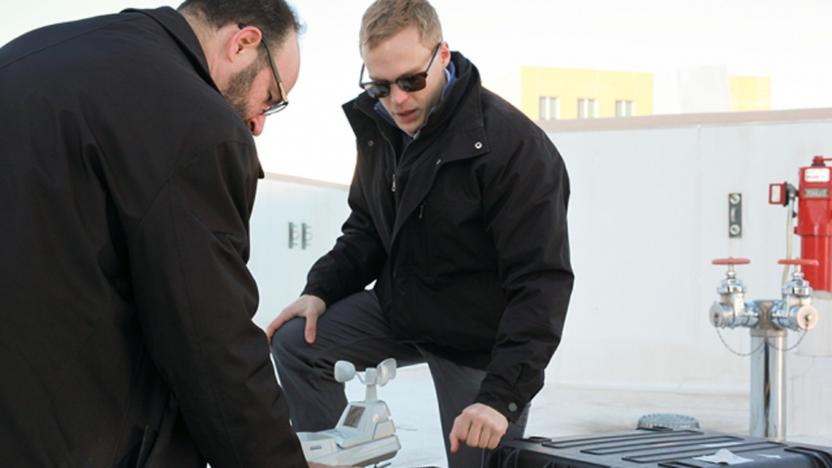
Device provides years of power through temperature swings
Eventually, you might not need a battery or a conspicuous external power source to keep a device running for years on end. A team at MIT has created a device that produces energy by exploiting the temperature swings that occur between day and night. Known as a thermal resonator, it uses a hybrid of materials that produce both high heat conduction and capacity. A copper or nickel foam at its core is coated with graphene to boost its conductivity, and is infused with a phase-changing material (octadecane) that serves as storage. Effectively, one side of the device is always capturing heat while the other is storing it -- you just have to harvest that energy with conventional techniques.

Broods used the Microsoft Band to create music-video magic
Microsoft is no stranger to collaborating with musicians to show off creative uses for its technology. With the Music x Technology project, the company has worked with acts like Big Grams, Neon Indian, KEXP, Phantogram and others to use its Kinect to enhance the musical experience for fans. I got a first-hand look at "Realiti: Inside the Music of Grimes" back at Moogfest in May, an exhibit that let fans remix parts of a song by interacting with a mesh surface. With the help of creative agency Listen, Microsoft teamed up with electropop duo Broods to produce a music video using the Microsoft Band.

2015 was the hottest year on record
If you needed further signs that humans are likely warming the planet, you just got it. NASA and NOAA have independently determined that Earth surface temperatures in 2015 were the hottest since record-keeping began in 1880, beating the 2014 average (the previous record) by a sizeable 0.13 degrees Celsius. Most of the on-record warming happened within the past 35 years, too. And you can't pin this on weather patterns like El Niño. While those conditions certainly contributed to 2015's higher temperatures, it was the "cumulative effect" of decades of warming that led to the new high.

Withings' sleep helper now uses Nest's thermostat to keep you cool
Withings' Aura sleep system can only do so much to help you rest by itself. Wouldn't it be nice if it could keep the climate just right, too? It can now -- the Aura just got support for Nest's learning thermostat. When they're linked up, the Nest will maintain an ideal temperature for sleep (around 64F to 68F, or 18C to 20C) once you're unconscious, and revert back to its earlier settings once you've woken up. It's a simple addition, and it won't be cheap at about $550 for the pair. Still, that cost might be justified if you frequently jolt awake because you're freezing or roasting.

Smart, touch-free thermometer gets temperatures for almost anything
There's no shortage of smart thermometers out there, but they tend to have one or more catches: many only work in certain conditions, aren't very pocketable or require some kind of contact. JoyWing's upcoming Wishbone may just tackle all of those problems in one fell swoop. The tiny, Y-shaped gadget plugs into your smartphone's audio jack and uses an infrared sensor to gauge temperatures without contact, regardless of whether you're pointing it at your baby's forehead, a hot drink or the great outdoors. It should be both accurate and fast (just two seconds to get a reading, the company claims), and the matching Android and iOS apps will let you track conditions over time.

Future phones will have security measures built into the glass
The glass on your smartphone screen doesn't do a lot right now: it lets pictures and touch input get through, and that's about it. It may pick up a few extra talents in the future, though. Researchers at Polytechnique Montreal have developed sensors that can sit under the surface of the scratch-resistant Gorilla Glass used in many mobile devices. Their approach etches optical waveguides into the display, letting it track changes in light. As a result, the screen can do things that would normally require either wiring or dedicated sensors. Your phone could check its temperature using light, and the manufacturer could even embed a unique optical pattern into the glass that lets the phone identify itself; it might get much harder to clone a device (and, presumably, its information).

Blue Maestro Tempo Bluetooth Smart Thermometer: Keeping tabs on your local environment
When I first heard about Blue Maestro's Tempo Bluetooth Smart Thermometer (£29.00, or about US$48), it was shortly after I had a conversation with a new friend about creating such a device. Ron, who I met on a recent cruise vacation, had wondered aloud why there wasn't an accessory for the iPhone that would let you check the local temperature. While his idea was more like a plug-in dongle for an iPhone or iPad, I think Ron would be happy with the Tempo Bluetooth Smart Thermometer. Specifications Dimensions: 2.87" x 3.54" x 1.1" (73 x 90 x 28 mm) Weight: 3.4 oz. (96.38 gm) with batteries installed Connectivity: Bluetooth Smart (requires iPhone, 4S, iPhone 5, iPhones 5S and 5C and all later models of iPhone; iPad Mini, iPad 3 and all later models of iPad; iPod Touch 5th Generation and all later models of iPod Touch. iOS devices need to be running iOS 6, iOS 7 and later operating systems.) Material: Polycarbonate case with nonslip silicone feet Batteries: Two AA cells (lifetime of about one year) Colors: Blue, Green, Gray, White, Black Accuracy: +/- .2 degrees Celsius Range: -13 degrees/167 degrees Fahrenheit (-25 degrees/75 degrees Celsius) Usable distance: Up to 75 meters line of sight Design Highlights For something that you're probably going to use around the house, the Tempo is quite attractive. It has a rounded triangular shape and looks more like a small art object than a temperature sensor. The three nonslip silicone feet ensure that you can place the Tempo on many surfaces -- even if they're not perfectly flat -- and it will stay in one place. Tempo is waterproof, so if you want to use it as an outside temperature monitor it will work just fine. Note that the low end of the temperature range is -13 degrees Fahrenheit (-25 degrees Celsius), and that a lot of locations in North America got that cold this year... The two AA batteries are fairly easy to get to -- I was able to pry open the case with a fingernail, and I know it will be a cinch to replace them in a year. There's only one button on the device, a small pushbutton that's placed directly in the center of mass of the Tempo. Push it and a small LED lights up on the bottom of the device, indicating that it's powered up and ready to talk to the accompanying Tempo Thermometer iOS app (free). Functionality Highlights Tempo comes with the two AA batteries pre-installed, so setting it up was very easy. I just preloaded the app on my iPhone and iPads, pushed the button on the bottom of the Tempo, and then watched as the temperature came up on the app. Initially it showed the temperature in degrees Celsius -- changing to Fahrenheit was easily accomplished through settings. The device stores up to 24 hours of temperature readings, so if you happen to be away from your Tempo for a while you can see what the temperatures were like for at least the last day. If you have more than one Tempo, it's simple to rename the devices with a more descriptive title, like "Bedroom", "Kitchen" and the like. The app shows all of the readings from your various Tempos. There's a small indicator that tells you if the iPhone and device are currently in Bluetooth contact or not, and it appears that the app shuts off its request for Bluetooth connectivity in between requests. Tapping on a specific reading opens up a chart showing either 12 hours (portrait) or 24 hours (landscape) of readings. There's also a "table" button that, when tapped, provides a list of hourly temperature readings that can converted to a PDF or CSV file for emailing. Unfortunately for me, the emailed file was in degrees Celsius, not Fahrenheit. For most of the world, that's not a problem! There's also a thermometer view that's available in the app -- a tap on a thermometer button brings up a replica of a bulb thermometer with scales in both Celsius and Fahrenheit. The app also allows users to easily set up alarms; perfect if you want notification when a certain temperature is reached. When I think about my friend Ron's need for an iPhone-centric thermometer, I know that the Tempo would only serve part of his needs. What he really wants -- and I have to agree with him -- is a device that could either be part of an iPhone case or a small dongle that could be plugged into the Lightning or headphone ports for easy on-the-go temperature readings. My hope is that the Blue Maestro team will have a success with Tempo and will work on a smaller, more portable device. Conclusion While it's not something you could carry in your pocket in order to make spur-of-the-moment temperature readings, Blue Maestro's Tempo is an attractive and very functional Bluetooth Smart Thermometer that's perfect for home or office use. Blue Maestro has done a good job of making the Tempo easy to set up, and the app is surprisingly full-featured. Rating: 3-1/2 stars out of 4 stars possible
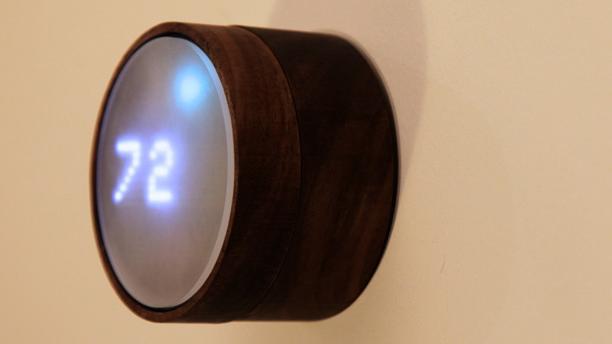
Spark shows how to build a Nest-like, open source thermostat
Wish you'd had the foresight to build the Nest thermostat and get Google's attention? You can't travel back in time, but Spark may give you the next best thing. It just posted a walkthrough showing how to build a smart thermostat of your own. The device centers around both the company's WiFi-equipped Spark Core as well as off-the-shelf displays and sensors from Adafruit, Honeywell and Panasonic. Its software won't compete with anything from Nest, but you can both change the temperature and view historical data from most any modern web browser. More importantly, it's open source -- you can program your own features or simply learn how things tick. While Spark's thermostat won't be an easy DIY project unless you're good with a CNC mill, it's proof that you don't need a vast array of resources to build your own climate controller. [Thanks, Binoy]

Honeywell Wi-Fi Smart Thermostat learns habits, matches your neon decor (video)
Honeywell has had WiFi-capable thermostats on the market for some time, but few of them would be a great match for home interiors that have escaped 1980s beige chic. The company's new Wi-Fi Smart Thermostat is going a long way toward bringing that design fully into the present century. Owners can color match the touchscreen interface with the paint on their walls, down to very exact shades. Of course, the thermostat wouldn't be much of a competitor in the Nest era if it didn't have some of that namesake intelligence underneath. As with its main rival, the Honeywell system has (already existing) Android and iOS apps, and can tell how long it takes to change the temperature; it's also aware of when filters need a change based on furnace behavior. If you're on the cusp of a home renovation and don't want anything so gauche as a differently-colored screen, home improvement shops should have the Wi-Fi Smart Thermostat this May for $249.

Ibis hotels to have robots paint art while they track your sleep: no, that's not creepy at all (video)
First they invaded our factories, and now it's our hotel rooms. Is nowhere safe from the robots? In truth, Ibis' upcoming Sleep Art project is very slick, even if it smacks of robot voyeurism. Ibis hotels in Berlin, London and Paris will let 40 successful applicants sleep on beds that each have 80 sensors translating movements, sound and temperature into truly unique acrylic paintings by robotic arms connected through WiFi. You don't have to worry that the machines are literally watching you sleep -- there's no cameras or other visual records of the night's tossing and turning, apart from the abstract lines on the canvas. All the same, if you succeed in landing a stay in one of the Sleep Art hotel rooms between October 13th and November 23rd, you're a brave person. We all know how this ends.

Netatmo Urban Weather Station tells iOS users when it's safe to brave the great outdoors (video)
We haven't seen weather stations garner the same level of clever mobile integration as other pieces of household gear -- like, say, thermostats. Netatmo wants its newly available Urban Weather Station to inject a similar dose of life into a category that some of us still associate with the thermometer by the window. The aluminum tube design certainly gives a fresh look to the WiFi-linked indoor and outdoor sensors, but the real trick is the matching iOS (and eventually Android) app. It's for more than just gauging the wisdom of biking to work: the free app tracks historical trends and shares them with fellow users in a network that Netatmo hopes will provide a better understanding of wider-scale and longer-term trends. The sensors go beyond just obvious air quality, humidity, pressure and temperature conditions as well, flagging noise levels and warning if the CO2 levels are high enough to warrant airing out the house. The $179 price for the Urban Weather Station isn't trivial, but neither is knowing just how well you can cope with your environment.

Google adds browser-based weather feature to tablets with temperature, wind and precipitation
You may have noticed Google's forecast feature on your HTML5-capable smartphone browser -- simply typing "weather" into the search field brings up a basic real-time temperature tool, complete with hourly and five-day forecasts for your current location. That feature has been around in one form or another since the beginning of last year, but as of this week, it's made its way to tablets, too. Web weather is entirely browser based, and you can bring it up in just the same way as on a smartphone -- confirm that your GPS is enabled, then head to Google.com and type "weather" -- you'll be rewarded with a 10-day forecast, complete with temp, precipitation, humidity and wind speed readouts. The tool is interactive, so while you may only be able to view a few days of weather at once, you can simply slide along the timeline to see more. The same applies to the hourly forecast as well. There's nothing to download or subscribe to for this one, and it's available right now at Google.com. James Trew contributed to this report.

Adafruit modder builds Captain Jack's Vortex Manipulator / Leela's wrist-lo-jacko-mator for real
This impressive wrist / forearm cuff is the brainchild of Adafruit forum member and modder Stephanie, who has built a sensor platform into the fashion accessory. The device can monitor the exposure value, track your movements over GPS, measure your galvanic skin response, tell you the temperature, humidity and even doubles as a watch and flash-light. It was built around Sparkfun's Pro Micro development board and a boatload of sensors purchased from Adafruit. We might just build one ourselves with a radiation detector, so that we can live out our Pip-Boy fantasies down at the mall. %Gallery-156412%

Study says wind turbines raise surrounding area temperature, but only at night
Who said the butterfly effect couldn't apply to renewable energy? Though wind farms are considered pretty green on the energy-generating spectrum, it looks like they, too, have an impact on the planet. According to a study published today in the journal Nature Climate Change, turbines can raise the local temperature -- albeit slightly. From 2003 to 2011, researchers monitored satellite data for west-central Texas, which is home to 2,350-plus turbines and four of the world's largest wind farms. In that decade, scientists observed a temperature increase of 0.72 degrees in wind farm regions compared to areas without turbines. That warming trend was especially marked at night, when the temperature difference between the ground and the air is highest. The temperature increase was also higher in winter; researchers say that these cooler, windier conditions cause turbines to generate more electricity and therefore create more heat. Since the study didn't find any change in daytime temperatures, it looks like we don't have to ring the global warming alarm just yet.








